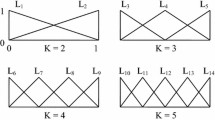Abstract
A new approach to design of a fuzzy-rule-based classifier that is capable of selecting informative features is discussed. Three basic stages of the classifier construction—feature selection, generation of fuzzy rule base, and optimization of the parameters of rule antecedents—are identified. At the first stage, several feature subsets on the basis of discrete harmonic search are generated by using the wrapper scheme. The classifier structure is formed by the rule base generation algorithm by using extreme feature values. The optimal parameters of the fuzzy classifier are extracted from the training data using continuous harmonic search. Akaike information criterion is deployed to identify the best performing classifiers. The performance of the classifier was tested on real-world KEEL and KDD Cup 1999 datasets. The proposed algorithms were compared with other fuzzy classifiers tested on the same datasets. Experimental results show efficiency of the proposed approach and demonstrate that highly accurate classifiers can be constructed by using relatively few features.
Similar content being viewed by others
References
Gorbunov, I.V. and Hodashinsky, I.A., Methods for constructing three-criteria Pareto-optimal fuzzy classifiers, Iskusstvennyi Intellekt Prinyatie reshenii, 2015, no. 2, pp. 75–87.
Scherer, R., Multiple fuzzy classification systems, in Studies in Fuzziness and Soft Computing, Berlin: Springer, 2012.
Cordon, O., Del Jesus, M.J., and Herrera, F., A proposal on reasoning methods in fuzzy rule-based classification systems, Int. J. Approximate Reasoning, 1999, vol. 20, pp. 21–45.
Vorontsov, K.V. Lectures on estimation methods and model selection. www.machinelearning.ru/wiki/images/2/2d/Voron-ML-Modeling.pdf
Dash, M. and Liu, H., Feature selection for classification, Intelligent Data Analysis, 1997, vol. 1, pp. 131–156.
Langley, I., Selection of relevant features in machine learning, Proc. of the AAAZ Fall Symp. on Relevance (New Orleans, 1994), New Orleans: AAAI, 1994, pp. 1–5.
Wang, L., Yang, R., Xu, Y., Niu, Q., Pardalos, P.M., and Fei, M., An improved adaptive binary harmony search algorithm, Information Sci., 2013, vol. 232, pp. 58–87.
Garcia-Galan, S., Prado, R.P., and Exposito, J.E.M., Rules discovery in fuzzy classifier systems with PSO for scheduling in grid computational infrastructures, Appl. Soft Computing, 2015, vol. 29, pp. 429–435.
Antonelli, M., Ducange, P., and Marcelloni, F., An experimental study on evolutionary fuzzy classifiers designed for managing imbalanced datasets, Neurocomputing, 2014, vol. 146, pp. 125–136.
Hodashinsky, I.A. and Gorbunov, I.V., Optimization of fuzzy system parameters based on the bee colony algorithm, Mekhatronika, Avtomatizatsiya, upravlenie, 2012, no. 10, pp. 15–20.
Hodashinsky, I.A. and Dudin, P.A., Identification of fuzzy systems based on the direct ant colony algorithm, Iskusstvennyi Intellekt Prinyatie reshenii, 2011, no. 3, pp. 26–33.
Hodashinskii, I.A., Zemtsov, N.N., and Meshcheryakov, R.V., Construction of fuzzy approximators based on the bacterial foraging method, Russian Physics Journal, 2012, vol. 55, no. 3, pp. 301–305.
Geem, Z.W., Kim, J.H., and Loganathan, G.V., A new heuristic optimization algorithm: Harmony search, Simulation, 2001, vol. 76 pp. 60–68.
Salman, A.A., Omran, M.G., and Ahmad, I., Adaptive probabilistic harmony search for binary optimization problems, Memetic Computing, 2015, vol. 7, pp. 291–316.
Lee, K.S. and Geem, Z.W., A new meta-heuristic algorithm for continuous engineering optimization: Harmony search theory and practice, Comput. Methods Appl. Mech. Eng., 2005, vol. 194, pp. 3902–3933
Yen, J., Application of statistical information criteria for optimal fuzzy model construction, IEEE Trans. Fuzzy Systems, 1998, vol. 6, pp. 362–372.
KEEL-dataset- data set description. www.keel.es.
Fazzolari, F., Alcala, R., and Herrera, F., A multiobjective evolutionary method for learning granularities based on fuzzy discretization to improve the accuracy-complexity trade-off of fuzzy rule-based classification systems: D-MOFARC algorithm, Appl. Soft Computing, 2014, vol. 24, pp. 470–481.
Rothman, K.J., A show of confidence, New England J. Medicine, 1978, vol. 299, pp. 1362–1363.
Glantz, S.A., Primer of Biostatistics, New York: McGraw-Hill, 1994.
KDD Cup 1999 Data. http://kdd.ics.uci.edu/databases/kddcup99/kddcup99.html
Fossaceca, J.M., Mazzuchi, T.A., and Sarkani, S., MARK-ELM: application of a novel multiple kernel learning framework for improving the robustness of network intrusion detection, Expert Systems Appl., 2015, vol. 42, pp. 4062–4080.
Porto-Diaz, I., Martinez-Rego, D., Alonso-Betanzos, A., and Fontenla-Romero, O., Combining feature selection and local modelling in the KDD Cup 99 dataset, Lect. Notes Comput. Sci., 2009, vol. 5768, pp. 824–833.
Bolon-Canedo, V., Sanchez-Marono, N., and Alonso-Betanzos, A., Feature selection and classification in multiple class datasets: An application to KDD Cup 99 dataset, Expert Systems Appl., 2011, vol. 38, pp. 5947–5957.
Wang, W., Guyet, T., Quiniou, R., Cordier, M.-O., Masseglia, F., and Zhang, X., Autonomic intrusion detection: Adaptively detecting anomalies over unlabeled audit data streams in computer networks, Knowledge-Based Systems, 2014, vol. 70, pp. 103–117.
Bamakan, S.M.H., Wang, H., Yingjie, T., and Shi, Y., An effective intrusion detection framework based on MCLP/SVM optimized by time-varying chaos particle swarm optimization, Neurocomputing, 2016, vol. 199, pp. 90–102.
Author information
Authors and Affiliations
Corresponding author
Additional information
Original Russian Text © I.A. Hodashinsky, M.A. Mekh, 2017, published in Programmirovanie, 2017, Vol. 43, No. 1.
Rights and permissions
About this article
Cite this article
Hodashinsky, I.A., Mekh, M.A. Fuzzy classifier design using harmonic search methods. Program Comput Soft 43, 37–46 (2017). https://doi.org/10.1134/S0361768817010030
Received:
Published:
Issue Date:
DOI: https://doi.org/10.1134/S0361768817010030




